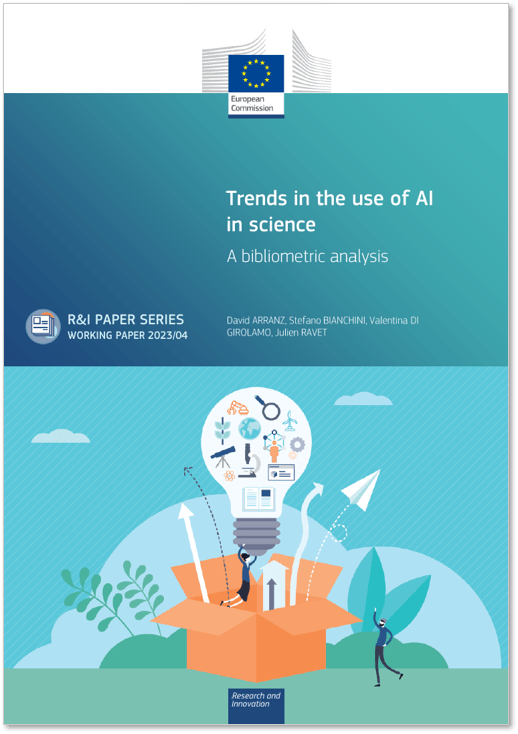
Trends in the use of AI in science – A bibiometric analysis
AI has an enormous potential to further advances in science and technology. Indeed, AI constitutes a powerful tool that is capable of inducing positive change across a broad spectrum of fields, thanks to its ability to allow humans to achieve more, and at a faster pace, by enhancing existing skills. This means that AI technologies are set to play a fundamental role in increasing the efficiency of scientific and innovation actions aimed at solving complex global challenges.
The applications of AI in science and research have grown at a significant pace in recent years. At the global level, China is the most productive, in terms of both the absolute number of publications and the growth rate of this output, followed by other key players, most notably, the EU and the US. Although the Chinese advantage is mitigated, in part, when considering indicators of research quality, its leadership in the development of AI and in its applications in science remains significant.
Based on the evidence presented in this paper, the gap between the EU and China in this regard can be expected to increase in the future. The EU led the way in the application of AI in science up to 2017, when it was overtaken by China. EU production is currently at a similar level to that of the US but it presents a somewhat slower growth rate. If this trend is confirmed, the window available for the EU to catch up with its competitors is likely to shrink further in the future.
Current trends highlight the need for actions that can strengthen the EU’s position in the application of AI in research and scientific activities. Given its multiple applications across a range of fields, AI is one of the digital technologies with the greatest potential to boost EU productivity, and to revitalize the green transition and, in this way, increase EU competitiveness. Moreover, if future scientific discoveries are likely to be driven in the main by AI applications and tools, lagging behind in the development and uptake of AI in science poses major challenges for the EU’s strategic autonomy, increasing the risk of developing dependencies in strategic scientific fields.
From a policy perspective, creating the right conditions to facilitate the uptake of AI across all scientific fields is no easy task. Based on the results of this paper, strengthening both the EU’s R&I ecosystems, as well as those of its Member States, to facilitate the further adoption of AI in science, is a key issue. Moreover, AI technologies introduce a series of broader challenges that policymakers have to address. Here, one of the most significant impacts to take into consideration is the impact of AI on jobs (including those in the domains of science). All changes in technology invariably lead to disruptions and threaten to exacerbate existing disparities. AI is no exception and particular attention will have to be paid to boost the uptake of AI technologies, while respecting human rights and preserving the value of human endeavour and intellect, in line with a human-centric, transparent approach that promotes public trust in this field.
Improving understanding of this technology at every stakeholder level is also critical. To achieve this, current tools and systems need to be reimagined to help researchers, companies, and policymakers exploit the potential of AI to the full. This, likewise, calls for a better understanding of the current state of knowledge in the field, so as to enable an effective prioritization of research at the boundaries of knowledge.
The increasing use of AI as a tool to advance science is accompanied by new challenges and dilemmas. Being a novel technology, AI is the cause of new concerns among scientists. The swift adoption curve, as described in this paper, will serve merely to intensify these fears. While some of these problems are known or, at least, expected, new dilemmas are likely to present themselves. A prime example of the challenges faced is the way in which generative models, especially LLMs, might affect different aspects of the scientific process (Birhane et al, 2023; van Dis et al., 2023). The perils of misuse also exist, most notably in potentially hazardous areas such as drug discovery (Shankar and Zare, 2022). At a broader scale, AI could impact the scientific process by introducing bias (for instance, in literature reviews) or creating obstacles for the reproducibility and interpretability of results.
It is, therefore, critical that steps be taken to improve the quality of available evidence when monitoring future trends and developments. In this regard, the relevance of the business sector is especially important. The interest shown in the application of AI in science by the tech giants, having large technological and financial power, (such as, Google, Microsoft, and Meta), and by their related startups, could be a major game changer in this field. The role of corporations in this regard (albeit an issue not specifically examined herein) could be of great relevance too. For example, in the UK, a huge share (70%) of leading publications on AI are generated solely by DeepMind.[1] Likewise, open science might well be impacted as the result of increased competition between companies, since this would have serious ramifications for openness in the uptake of ideas by the research community.
Finally, the impact of AI on scientific productivity clearly requires further analysis and monitoring. Quantifying the current impact of AI on the productivity of science is no easy task. The fact that the number of scientific publications using AI is growing faster today than the overall number of publications can be interpreted as an initial indication of the potential of AI to boost research productivity. The anecdotal evidence of projects such as AlphaFold[2] moreover points in this same direction. Results from this specific project highlighted enormous productivity gains in the scientific process, and opened up, at the same time, multiple additional lines of research in medicine and drug discovery.[3] This is an excellent example of the potential of AI tools. However, further research is needed to quantify the actual impact of AI and its evolution, taking into account other criteria beyond that of scientific production (e.g., novelty, originality, and disruptiveness).
[1] The UK’s share of citations in the top 100 recent AI papers stands at 7.8% but once DeepMind’s contributions are removed, it falls to 1.9%: https://www.ft.com/content/470e9848-b2dd-4ad5-94cb-65e95c226545
[2] AlphaFold, with an interdisciplinary team of around 20 scientists, was able to predict the structure of 200 million proteins in a period of between 5 to 6 years. Before this, predicting just one structure could be the work of a significant part of a PhD thesis.
[3] The AlphaFold study was the most cited AI paper in 2022: https://www.zeta-alpha.com/post/must-read-the100-most-cited-ai-papers-in-2022
Document Details and Download
- Adobe Campaign Standard Implementation
- artificial intelligence
- Multidisciplinary Research
- Scientific Research






Trends in the use of AI in science – A bibiometric analysis 0 reviews
Login to Write Your ReviewThere are no reviews yet.